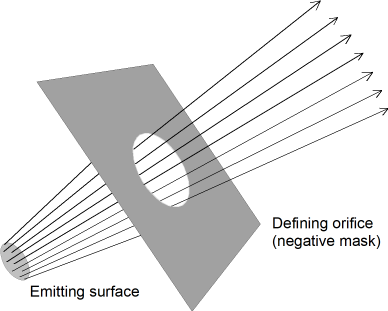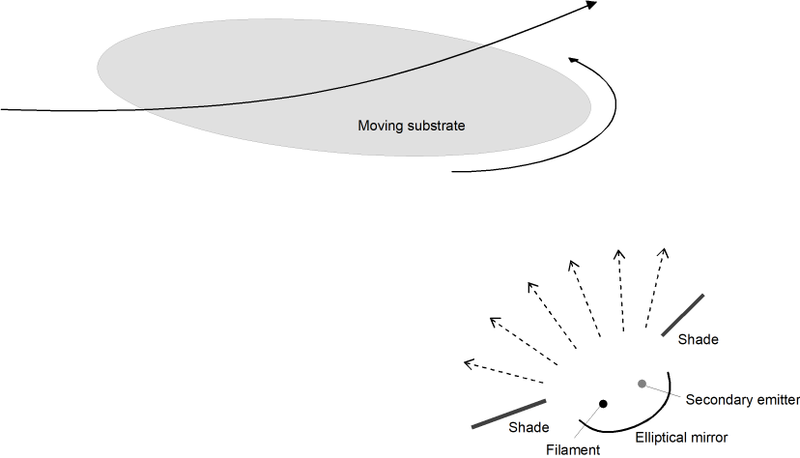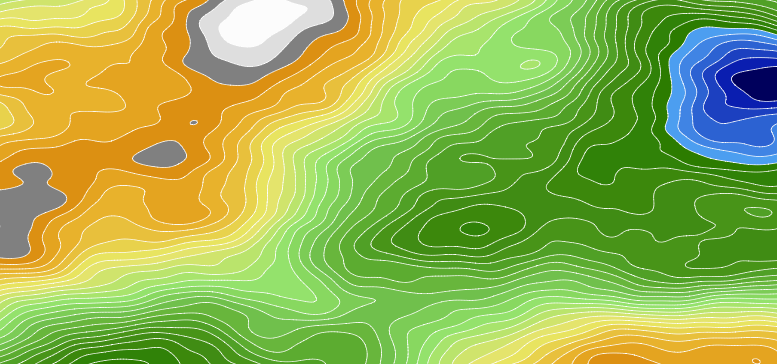Application Notes, May 2024
Modeling of General Flux Problems
At the core of V-Grade 5S series programs is a flux generation and integration tool. These programs may be employed in studies of a variety of processes or natural phenomena involving radiative flux. The following are two examples related to thin-film manufacturing.
Ion Beam Bombardment
V-Grade 5S programs can be employed for studies of ion-beam bombardment for material modification during growth (via energy transfer), post-deposition etching, or milling. In these processes, uniformity or gradients of the cumulated bombardment may be of interest. The angle-of-incidence statistics may also be of importance.
Feature sets in Source panel and Shadow Mask panel of V-Grade 5S programs allow accurate modeling of ion sources of various types and geometries, including gridded and non-gridded sources.
While a non-gridded ion source may be modeled in a way similar to a vapor source, collimated ion beams from gridded sources may be conveniently modeled with the help of an orifice (a negative mask), as shown in the diagram below.
A combination of the following elements can bring about high realism in modeling ion beams:
1. An emitting surface can be of any shape and curvature;
An emitting surface can be of any shape and curvature;
2. Each emitting point can have its own direction vector;
Each emitting point can have its own direction vector;
3. Use plume parameters to shape beam profile;
Use plume parameters to shape beam profile;
4. Customize the geometry and placement of beam-defining shadow mask(s).
Customize the geometry and placement of beam-defining shadow mask(s).
A drawback of employing a beam-defining orifice is the need of reposition the mask whenever the source is repositioned or repointed. An alternative is to use large-valued exponents of the cosines in the plume function for simulating a focused beam, eliminating the need of a beam-defining mask.
Radiative Heating
Substrate heating with lamps inside vacuum chambers is a common technique for thin-film deposition. As substrates are moving, uniform heating of the substrates requires a thoughtful arrangement.
With a V-Grade 5S program, the heat deposition can be modeled in a very similar way as a material deposition.
The lams(s) can be introduced in the Source panel. They may be a point source or occupy a finite area or volume, just like a vapor source. For incandescent lamps, whose emission can be considered omnidirectional, a single spherical term can be assigned to the plume function:
C1 = 1;
epsilon1 = 0;
C2 = C3 = 0.
Light shades, if present, can be modeled with the shadow mask tools. In some cases the effects of reflectors, if present, can be accurately modeled through secondary emitters. Shown in the figure below is a lamp having a filament situated at a focal point of an elliptical mirror. In many cases it is sufficient to treat a lamp as a finite heat-emitting surface, much like a compound vapor source.
Copyright © 2024 Tin Model LLC. All rights reserved.
V-Grade 5S for Solar-Energy Installations
In a different arena, V-Grade 5S programs may be employed for studying a similar problem: solar-energy deposition in terrains, buildings or solar farms. For these studies, the geographic location of a site and topography of the terrain can be modeled with features for 3D substrates that undergo prescribed rotations and orbiting motion. Such models can predict, among other matters, daily and seasonal variations in the energy deposition, optimal placement of solar panels and effects of shadow-producing objects.



